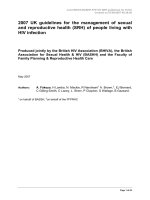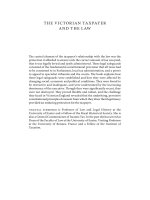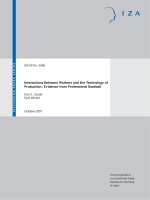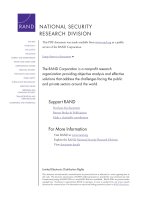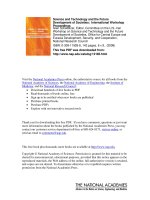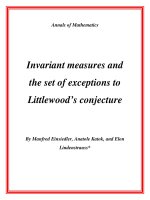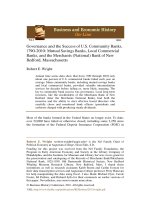Understanding English Language Learners’ Needs and the Language Acquisition Process: Two Teacher Educators’ Perspectives doc
Bạn đang xem bản rút gọn của tài liệu. Xem và tải ngay bản đầy đủ của tài liệu tại đây (3.86 MB, 20 trang )
ON POINT
Understanding English Language Learners’
Needs and the Language Acquisition Process:
Two Teacher Educators’ Perspectives
Great Urban Schools: Learning Together Builds Strong Communities
The mission of The naTional insTiTuTe for urban school improvemenT
(NIUSI) is to pa r t n e r with Regional Resource Centers to develop powerful
net w ork s o f u r ban loc a l e duc a tio n a g enc i es and schoo ls that embra ce and
implement a data-based, continuous improvement approach for inclusive practices.
Embedded within this approach is a commitment to evidence-based practice in
early intervention, universal design, literacy and positive behavior supports.
The Office of Special Education Programs (OSEP), of the U.S. Department of
Education, has funded NIUSI to facilitate the unification of current general and
special education reform efforts as these are implemented in the nation’s urban
school districts. NIUSI’s creation reflects OSEP’s long-standing commitment to
im p r o v i n g e d u ca t io n a l ou t c o m e s f o r al l ch i ld r e n , s p e ci f ic a l l y t ho s e wi t h
disabilities, in communities challenged and enriched by the urban experience.
1
ON POINT SERIES
Alicja Rieger, Utica College
Ewa McGrail, Georgia State University
©2006 NIUSI
Understanding English Language Learners’
Needs and the Language Acquisition Process:
Two Teacher Educators’ Perspectives
WHAT IS THIS ONPOINT ABOUT?
This OnPoint tackles the complexity of English
language learners’ needs from our point of view.
We are native Polish-speaking teacher educators
who use our own experiences and knowledge as
English language learners in methods courses
that we teach in teacher education programs
in the United States. We both were born and
raised in Poland, and share our passion for our
native language and culture with our students,
who are either already practicing public school
teachers or in the process of becoming teachers.
We refer to both groups as teachers in this
OnPoint. Both groups of teachers are earning
their master’s degrees to better serve students
in multi-lingual classrooms in K-12 settings. In
support of these teachers’ educational goals, we
provide them with opportunities to experience
first-hand some of the key components of
second language acquisition in focused
instructional engagements
—
what Vaughn, Bos,
and Schumm (2003) classified as more natural
opportunities to develop an understanding of
English language learners’ needs. Finally, in
our college classrooms, we provide our teachers
with opportunities to develop a more formal
framework for second language acquisition
pedagogy for students in K-12 settings.
WHAT IS THE CHALLENGE FOR
STUDENTS AND THEIR TEACHERS?
English language learners may have begun their
lives speaking any one of 6,500 living languages.
Imagine teaching a group of students who grew
up speaking Korean, Somali, Chinese, Russian,
Polish, Spanish, and Black English-all in the
same class (Pang, 2005). Striking a balance
between valuing language diversity and
ensuring that each student has access to high
quality academic instruction in their native
language as well as English is complicated
politically, socially, and academically.
English only amendments have been sponsored
in several states and, as of 2006, passed in at
least three states (Arizona, California, and
Massachusetts). Other states, like Colorado, in
highly politicized elections, defeated similar
amendments, although the margin of victory was
slim. Many business leaders, researchers, and
members of non-English linguistic communities
believe that embracing the rich cultural and
linguistic resources of children who speak more
than one language enriches the perspectives and
understanding of monolingual students
(Cochran
-
Smith, 2006; Kaplan, 1994; Pang, 2005). From
this perspective, global citizenship is best
cultivated when diverse languages and cultures
are part of the lived academic experience.
The political and policy dimensions associated
with English language learners represent only
some aspects of this complex arena. Teachers
and the schools that employ them need systems
in place that support students who are second
language learners in an English dominant context.
When an English dominant school enrolls
English language learners who speak a variety of
languages, there is little likelihood that the school
will have translators available who speak all the
languages of their students. Further, like native
2
”
“
Ahmad is a three-year
old boy from Afghanistan.
His family left the Afghan
capital, Kabul, during the
Taliban regime and came
to the U.S.A. Ahmad
entered an English-
speaking classroom at the
age of five with Afghan
Persian (Dari) as his first
language and since then
he hasn’t been a
successful English
language learner. At this
point, Ahmad’s parents
cannot be much of help to
their son because they
also are still striving to
understand the English
spoken around them.
3
English speakers, English language learners who
are academically proficient in their first or native
language represent differing levels of academic
experiences, abilities, and interests in addition to
their language proficiency. Some students read
above their grade levels; others struggle with daily
instruction. Some have highly supportive
home environments for language and literacy
development; others live without any access
to books or literacy rich environments.
The number of English language learners has
increased considerably in the US. In the 2003-
2004 school year, 5.5 million school-age children
were English language learners—an increase of
nearly 100 percent from a decade earlier (Leos,
2004). The number of public classroom teachers
prepared to teach children like Ahmad, Shizuko,
and Carlos remains consistently low. According
to the US Department of Education National
Center for Education Statistics (2003):
Thirty percent of public school teachers instructing
LEP
(Limited English Proficiency)
students have
received training for teaching LEP students,
and fewer than 3 percent of teachers with LEP
students have earned a degree in ESL (English
Second Language) or bilingual education.
1
Similarly, the needs of English language
learners are not addressed in a systematic and
programmatic manner in core curriculum
requirements for teacher education candidates
(Dalton, 1998). While the NCLB legislation
requires K-12 teachers to be “highly qualified”
to teach in the content areas of science, math,
social studies, and English language arts, as
well as in physical and vocational education,
it does not require teachers to be highly
qualified to teach English language learners.
Short and Echevarria (2004, December/2005,
January) speak to this matter:
Although No Child Left Behind calls for highly
qualified teachers in every core academic
classroom by 2006, few states require that
the teachers of core content areas have any
background or training in second-language
acquisition, English as a second language (ESL)
methods, or cross-cultural communication.
(p. 10)
Many English language learners spend most of
their academic life with teachers who speak
only English and who are not prepared to fully
understand their varying needs as English
language learners. In order for today’s teachers to
meet the challenge of educating a richly diverse
generation of children, they need to learn a great
deal about second language acquisition and
effective pedagogy for English language learners
through pre-service teacher education programs
and in-service professional development
opportunities (August & Hakuta, 1997).
TEACHING TEACHERS ABOUT
SECOND LANGUAGE
ACQUISITION PROCESSES
One way of increasing teachers’ knowledge
about the process of second language
”
“
Shizuko is a Japanese
teenager who is also a
fluent speaker of Chinese
and Vietnamese since her
parents had traveled
extensively to China and
Vietnam during her early
childhood. Unfortunately,
when she arrived in
America, her English
communication was very
limited. Since then, she
has improved her spoken
English significantly.
However, her reading and
writing skills in academic
English are still very poor.
She often seems to be
totally lost in the complex
language of most of her
high school textbooks
and she is unable to
complete successfully
even simple written
assignments. Few people
have asked her why.
1
U.S. Department of Education terminology
acquisition is through second language
acquisition simulations. In designing such
simulations in our teacher education
courses, we follow Krashen’s (2005) advice
to immerse our teachers in first-hand
experiences of the second language
acquisition process. While Krashen may
begin a lesson speaking German to help
students experience the emotional and
intellectual challenges that English language
learners experience in a classroom where
teaching and learning is conducted in
English, we begin in a similar vein. For
instance, we begin one of our methods
classes by speaking Polish, our native language,
and reading aloud Szymborska’s poem,
Advertisement (1997, p. 14). Szymborska is a
native born Polish poet and the recipient of
the 1996 Nobel Prize award in Literature.
Not surprisingly, the most typical responses
to our reading aloud of Szymborska’s poem
in Polish are nervous laughter and confused
faces. No one understands what we have just
read. In response to the students’ discomfort,
we reread the poem, this time a little louder,
or provide a written version of the poem in
the Polish language. After several of these
reiterations of the poem in Polish, we ask in
English a simple question: “Did it help?” Our
college students still continue to laugh and
shake their heads not only because they
indeed did not understand much of what was
read to them, but also in the acknowledgment
of the most typical mistake that they as
teachers do to English language learners: a
failure to realize that mere-rereading of the
text, speaking louder, or even writing words
on the board will not increase English
language learners’ understanding of the
content in a new language that is beyond their
level of comprehension (Krashen, 1985).
We go on to provide our students with both
the Polish and English versions of the poem,
and ask them to first read the Polish version
of the poem line by line and make intelligent
guesses as to the meaning of the words. In
doing so, we give our teachers the
opportunity to test, in an unfamiliar context,
the skills of meaning making, such as context
and other cue analyses, reference to prior
knowledge and experiences, prediction, and
hypothesizing. Such learning encourages a
careful study of language features at the
sentence and word levels. In addition
students hone their skills at risk-taking,
posing questions and offering solutions, as
well as collaborative learning. At the same
time we teach them the vocabulary necessary
to understand the poem, using bilingual
Polish-English flash cards and a bilingual
tape-recorded version of the poem read
slowly line-by-line in both Polish and English.
Only then do we ask our college students to
consult the written English version of the
poem for verification of their interpretations.
Once the poem’s meaning is established with
the support of the English text, we proceed to
discuss the more abstract meaning of the poem
and its further implications for their lives and
pedagogy. With this, and similar simulation
activities, teachers in the our college classrooms
learn an important lesson about the second
4
”
“
Because his mother was
deported as an illegal
immigrant, Carlos lives
currently with his
grandmother in Florida
while his father moves
from one place to another
in search of manual labor.
Carlos had been
mainstreamed into
English-only speaking
classrooms since his
arrival, but he has not yet
been a successful English
language learner. Carlos
is currently a fifth-grader,
reads at a third grade
level and he is not
successful on written
tests. He fails to attend
school on a regular basis.
He misses Cuba, and his
family and friends there.
5
language acquisition process that we acquire
language naturally only when the context
becomes meaningful for us as learners. There
are many strategies for making linguistic input
more comprehensible for English language
learners in general education classrooms.
ADDRESSING THE SOCIAL
COMPLEXITIES OF TEACHING IN
A MULTI-LINGUAL CLASSROOM
Based on the experience with Szymborska’s
poem in our college classrooms, we draw
our students’ attention to one of the
most common characteristics of English
language learners-their silence and lack of
participation in the English classroom.
This is because they are afraid of being
ridiculed and humiliated if they make errors
in front of their peers and teachers. Like
many other language learners, the teachers in
our college classrooms were afraid of making
mistakes in interpretation of Szymborska’s
poem, experiencing a mild version of what
Krashen (1985) defined as “a mental block
caused by affective factors” (p. 100).
Many English language learners struggle
with feelings of inadequacy, fear of failure,
low self-esteem and isolation. These
feelings are associated with issues such as
heavy accents that are mocked or ridiculed,
grammatical errors in their oral speech,
limited vocabulary, and lack of information
about the social morays and behavior
patterns in the classroom. A set of
recommendations from the New York State
Association of Foreign Language Teachers
provides strategies for teachers to use to
reduce the affective issues that complicate
the process of language acquisition. This set
of recommendations was adapted by one of
our in-service teachers, Nash (2005), in her
Spanish classroom and is cited below:
SMILE WHEN YOU SEE ME
Every
day, I smile and greet my students in
Spanish as they enter the classroom.
This practice has allowed me to better
understand my students and recognize
when they have a day with low self-
esteem. Creating rapport with my students
facilitates a meaningful conversation
with them; this exchange of ideas can
be vital in increasing their self-esteem.
CALL ME BY NAME
During the first
week of school, my main objective resides
in getting to know my students and
remember their names. Just by listening
to the teacher or their classmates calling
their name fosters in a child a positive
feeling, a feeling of being alive, and of
being important to someone because that
someone has actually taken the time to
learn, pronounce, and utter their names.
LET ME KNOW THAT YOU MISSED
ME WHEN I WAS ABSENT
I let my
students know that I missed them when they
were absent. Many times, during their
absences, I call the students by phone, or
send a “get well soon” card. In addition to
acknowledging my students when they miss
a class, I stay alert to every change in the
student; for instance, I am always alert to
compliment a haircut, a beautiful smile,
or a nice sweater. Knowing that others
care and pay attention to them helps
students with their self-esteem.
RECOGNIZE MY OWN SPECIAL
TALENTS, EVEN IF THEY DO NOT
SHOW UP ON MY REPORT CARD
I believe that every person has something
beautiful inside; I look for this beauty
in each one of my students, and I make
sure they know how special they are.
I praise students for having an impressive
handwriting, for their creativity, for
their good memory, for being good
classmates, and for having a positive
attitude among other qualities they reveal.
PRAISE ME WHEN I DO SOMETHING
RIGHT
All children, especially English
language learners need encouragement and
praise. We must be honest and sensitive
and, every time they convey a valid answer
or input, we should share these with the
class and give them credit for their views.
We must pay specific attention to these
students and value their ideas; this will
help them increase their confidence.
IF YOU DO NOT LIKE SOMETHING
THAT I DO, HELP ME UNDERSTAND
THAT YOU STILL LIKE ME AS A
PERSON
Students need to know that
we care about them. Attentiveness,
expectancy, attitude, enthusiasm, and
evaluation are characteristics that
significantly influence the self-esteem of
the student. “All of us need to convey to
our students … every day that ‘you are
important to me as a person’ (Wong &
Wong, 2001, p. 65). (Nash, 2005, pp. 6-7).
We encourage our teachers to create
opportunities for interactive and
recreational reading for their own students
from diverse linguistic backgrounds. For
example, younger readers can be motivated
to read voluntarily with the help of a
multi-sensory (see, touch, hear, and learn)
early literacy tool such as the Language
First Program. The program combines
interactive technology “with 36 leveled
books to develop oral language skills and
essential vocabulary at all levels of English
proficiency … Native language support
allows students to hear instructions in their
primary language” (Educational Leadership,
2004 December/2005, January, pp. 81-82).
While English language learners are
engaged in recreational reading activities
offered by the Language First Program,
they acquire new vocabulary and spelling
as well as new foreign language structures,
syntax, and grammar in a risk-free and
supportive English language environment.
We also provide teachers with the research
that supports a positive correlation between
free interactive reading and increased second
language literacy competencies. Krashen
(2004), for instance observed that second
6
language learners improved English proficiency
simply by reading novels written for young or
teenage girls, such as Sweet Valley Kids, Sweet
Valley Twins, and Sweet Valley High. Krashen
also noted that English language learners in
his study responded well to small doses of
voluntary and light reading, as opposed to
large doses, which tended to make such
reading distasteful, rather than a pleasant
experience. Similarly, Ujiie and Krashen
(1996) observed that light reading helps to
bridge everyday conversational language and
academic language in the classroom.
Additionally, in our college classrooms, we
promote field related experiences such as, book
clubs where we ask our teachers to pair up
with English language learner children at the
primary and secondary school levels in order to
provide them with voluntary and light reading
activities as well as allowing them to listen to
their voices and ideas as English language learners.
Reeves (2004 December/2005, January) had
this in mind when she called on the need for
researchers and teachers to be active listeners and
“student teachers” in the journey of learning how
to teach English language learners. She wrote:
I wondered why those of us who discuss and
research the best ways to help students learn
English as a second language don’t routinely
make students’ ideas and perspectives part of
the conversation. Why not make a place at the
policymaking table for the voices of those most
directly affected by instructional policies?…
Teachers and researchers need to be gentle,
encouraging, and patient in that listening. (p. 72)
As part of the field experience, teachers
and teacher candidates are asked to
create weekly journal entries that focus
on observations of and interactions with
students including English language
learners in public school settings. Students
are to connect their knowledge base
about English language learners to these
observations and experiences so that
they can strengthen their own teaching
practices. Here is a sample of such a
reflective journal entry written by one of
the teachers, Sehic (2005), who was in
a high school setting and learned that humor
is a good motivator that is well received by
English language learners. He wrote:
In one ESL class that I observed during
my fieldwork study, the teacher tried
to teach the students who do not speak
English language the general view on the
history of civilization. Instead of using books
and other written documents, she showed
them a comedy movie about historical
figures and events that were presented in a
funny way. Some other ways that I have
observed during my fieldwork study is that
some teachers tend to tell something funny
that happened to them during the week.
Also, they would use appropriate jokes
during the instructions, like imitating the
voices of some famous people or rewarding
the students with a joke at the end of the
class. The ESL students found this type of
instruction very interesting and they were
motivated to learn the required lesson by
the humor that the instructor used. (p. 15)
7
WHY DO TEACHERS NEED TO
MAKE CONNECTIONS WITH
FAMILIES OF SECOND
LANGUAGE LEARNERS?
In our experience of preparing teachers for
working with learners from diverse cultural
and linguistic backgrounds, we also emphasize
the need to understand patterns of family
language literacy. We believe that the habits
and practices acquired in the classroom should
complement the literacies that are maintained
in English language learners’ homes
To practice this philosophy, we ask our
teacher candidates and in-service teachers
to design activities to help English language
learners identify their home literary patterns
and facilitate their writing or storytelling by
sharing stories about their daily activities
during family leisure time. Taylor (1993)
suggested that such activities provided
natural opportunities for valid literacy
experiences. Composing and talking about
family daily activities also encourages a
collaborative learning language experience,
in which families of English language
learners share meaningful literacy
experiences with their own children.
Furthermore, such projects can give public
classroom teachers insight into familial
literacy patterns and second language
proficiency. This, in turn, can inform their
daily instructional design so that it is both
realistic and easily accessible to all children
and their families. For instance, in one
lesson plan designed by a teacher candidate,
8th-grade English language students were
asked to conduct a survey on their most and
least favorite food in the school cafeteria.
Then they wrote a persuasive essay to the
principal requesting a menu that included
some of their own culture’s culinary
preferences. In another lesson
plan for 6th-graders, English language
learners were asked to complete their
own family picture book depicting their
family life. They not only had to list their
own family traditions and celebrations, but
also discuss the individual family member’s
contributions to the family unit.
Integrated learning centers are further
examples of skillfully orchestrated language
instruction for promoting nurturing and
productive family traditions. For instance,
the learning center, Homes: Where People Live,
invites young students to explore various
kinds of housing (e.g., townhouse, pagoda,
duplex, farmhouse, and trailer) and design
and construct a replica of their own home.
Within this learning center, students can also
compare the cultural and aesthetic aspects of
different types of homes in the United States
with those of other countries. They thus learn
how differently people live across the world,
while at the same time acquiring new
vocabulary to talk about where people live.
The key in teaching second language
acquisition, however, is in infusing students’
culture of origin into the language curriculum
in a thought-provoking and planned manner,
because, as Peterson and Coltrane (2003) argue:
8
9
The culture associated with a language
cannot be learned in a few lessons about
celebrations, folk songs, or costumes of the
area in which language is spoken. Culture
is a much broader concept that is inherently
tied to many of the linguistic concepts taught
in second language classes (p. 1).
One of the ways to incorporate culture in a
more
meaningful way for English language
learners is a multimedia case study approach.
We engage our teacher candidates and in-
service teachers in an analysis of multimedia
case studies. We may feature a single teacher’s
use of picture books to develop concepts. For
analysis purposes, we ask our college students
to respond to questions such as the following:
What type of linguistic resources and cultural
references does the teacher use to support
English language learners’ subsequent
learning of teacher- identified concepts?
What types of instructional strategies does the
teacher use to activate students’ prior knowledge,
and to engage them in follow-up activities?
How do students respond to the teacher’s
linguistic resources, cultural references, and
pedagogy?
After our teacher candidates and in-service
teachers engage in a reflective analysis of the
selected multimedia cases, we invite them to
watch a video in which the teacher explains the
rationale and the goals for the lesson they
observed. Reviewing this post reflection allows
our teacher candidates and in-service teachers
to compare their own responses with the ones
provided by the teacher in the featured
video. Such learning also provides teacher
candidates and in-service teachers with
concrete suggestions for further improvement
of their own teaching of students from
diverse linguistic and cultural backgrounds.
WHY DO TEACHERS NEED
TO PROVIDE AN EXPLICIT
INSTRUCTION ON VERBAL AND
NONVERBAL COMMUNICATION
TO ENGLISH LANGUAGE
LEARNER STUDENTS?
In our college classrooms, we also emphasize
that English language learners do not only
need to increase their spoken language
proficiency; they also need to become familiar
with the unspoken cultural behaviors and
communication patterns of a second language
speech community. Often, both verbal and
non-verbal communication patterns within a
second language community culture may be
drastically different from those English
language learners are familiar with as
members of their own social group and speech
community. Eva Hoffman (1989) reflected
upon these differences poignantly in books and
essays describing her individual journey into
English as her second language as well as the
ways the two languages and cultures, her home
language and culture and the new language
and culture she was acquiring, were impacting
her own identity construction as a teenager:
I learn my new reserve from people who take
a step back when we talk, because I’m
standing too close, crowding them. Cultural
distances are different, I later learn in a
sociology class, but I know it already. I learn
restrain from Penny, who looks offended when
I shake her by the arm in excitement, as if my
gesture had been one of aggression instead of
friendliness. I learn it from a girl who pulls
away when I hooked my arm through hers as
we walk down the street—this movement of
friendly intimacy is an embarrassment to her.
I also learn that certain kinds of truth are
impolite. One shouldn’t criticize the person
one is with, at least not directly. You shouldn’t
say, “You are wrong about that”—though you
may say, “On the other hand, there is that to
consider.” You shouldn’t say, “This doesn’t
look good on you,” though you may say, “I
like you better in that other outfit.” (p. 146)
To increase our teacher candidates’ and in-
service teachers’ awareness of such cross
cultural differences in behavior and
communication patterns, in our college
classrooms, we use a suggestion from Pang
(2005) to show clips from the film, Shall We
Dance? (Masayuki Suo, 1996). The main
characters in the movie are three middle-
aged Japanese accountants, who, by taking
lessons in ballroom dancing, violate the
stereotypes of Japanese as overly reserved,
serious, and workaholic. The selected
episodes from the film allow us to begin
discussion about the values and emotions
that Japanese culture and body language may
convey. We further discuss some of the
similarities and differences among Polish,
American, and Japanese cultures, focusing on
issues such as female/male relationships, the
work ethic, and family roles. We are careful
to acknowledge within culture differences
since neither people within cultures nor their
cultural practices are homogeneous.
Because the film has subtitles, if we are
fortunate,
we invite students who speak
Japanese or have visited Japan as tourists to
comment on the dialogue and the underlying
cultural values that they see expressed via
body language and non-verbal
communication patterns in the film. In
utilizing our Japanese students’ cultural
capital, we provide them with opportunities
to teach us about aspects of their culture in
a more direct and personal way. When we
are not fortunate enough to have a
Japanese student in our college classrooms,
we invite a Japanese guest speaker to act in
that role. Our local offices of international
students and faculty have always been
wonderful suppliers of such speakers.
WHY DO TEACHERS
NEED TO DIFFERENTIATE
BETWEEN CONVERSATIONAL
AND ACADEMIC LANGUAGE
PROFICIENCY?
We also sensitize our teacher candidates and
in-service teachers to another common
misconception about English language
10
11
”
“
If the learner
is fluent in
conversational
language he or
she is equally
proficient in
academic
English, and that
he or she is equally
knowledgeable
about language
nuances. Right?
Wrong, wrong, and
wrong again.
learners: if the learner is fluent in
conversational language he or she is equally
proficient in academic English, and that he or
she is equally knowledgeable about language
nuances. Right? Wrong, wrong, and wrong
again. Cummins (1984) differentiates
between two types of language proficiencies:
Basic Interpersonal Communication Skills
(BICS) and Cognitive Academic Language
Proficiency (CALP). BICS proficiency
encompasses the language needed for social
situations, which typically occurs in highly
contextualized and relatively low cognitive
demanding settings. Success in school is
dependent of the students’ ability to acquire
CALP. It may take a child approximately two
years to develop BICS, but the level of
proficiency needed for CALP can take from
five to seven years to develop (Ovando &
Collier, 1998). We make our college students
aware of these facts and as a result, sensitize
them to the need to give English language
learners in their classrooms time to grow and
develop. To reinforce this concept among our
teacher candidates and in-service teachers, we
refer to Pang’s (2005, p. 297) stages of second
language development. As Figure 1 shows
English language learners often initially
experience a silent or non-verbal period,
during which they absorb the information in
the second language, even though they may
not be proficient yet in producing the
linguistic output, spoken or written.
In our college classrooms, we also draw
attention to the fact that at the intermediate
fluency stage of language development,
English language learners need concrete and
frequent feedback from their teachers, to be
able to develop the ability to self-monitor
errors, especially the errors in transfer
resulting from cross-linguistic influence.
Errors in transfer occur when English
language learners bring linguistic features
Figure 1 StageS oF Secon d - Lang uage deve Lopment
preproductio n —
SiLent Stage
Individuals are listening to the sounds and ways people put words together. They listen for
patterns. This is also known as the silent period because the language learner has a much
larger receptive vocabulary than speaking vocabulary.
earLy
pro ductio n
Individuals learn to answer some questions that can be replied to with a yes or no answer.
They may be able to produce short sentences such as “How much?”
Speech
eme rg ence
Individuals convey basic ideas and create short sentences. They are becoming more
comfortable speaking to others and can correct some of their errors in sentence structure.
interme diate
FLuency
Individuals can convey more complex ideas although they are still having trouble creating
correct complete sentences. They are speaking more naturally and confidently.
Pang, V. Ooka. (2005). Multicultural education: A caring-centered, reflective approach (2nd. ed.). Boston, MA: McGraw-Hill.
12
such as grammar, syntax, and punctuation of
their native language into the English
language, be it written or spoken. For
example, some of the typical problems in
writing that Polish students face when
learning English as a second language are due
to the fact that in Polish, you need to apply
gender not only to people but also to objects.
Thus, the writing ‘errors’ in the following
sentences: “Please pass me that book. She is
there on desk,” or “I was so hurried today
that I forgot to make bed” are neither careless
nor random, although they might appear so
to someone who had no knowledge of Polish.
They have logical and semantic validity in
Polish grammar, which lacks definite articles,
and identifies gender in inanimate objects.
Finally, in our college classrooms, we encourage
our students to educate themselves about the
errors in transfer specific to the native
languages spoken in their present or future
K-12 classrooms, to be able to identify errors
in transfer in their students’ work and speech
and, more importantly, to be able to give
their English language learners more precise
feedback on how to eradicate such errors in
their future communication in English.
With such feedback from their teachers, second
language students in K-12 English classrooms
are more likely to be motivated to write
more and better, because instead of hearing
for years, ‘Your writing errors are fatal,’ they
will realize that their problems in writing are
not because of ‘being dumb,’ but because of
their transfer of native language features into
English writing. With such an understanding,
English language learners are also better
prepared to take ownership of their learning
a second language and to monitor such errors
in spoken or written communication.
CONCLUSION
To close, the overarching message is that the
increasing population of English language
learners in our public school classrooms
obligates our teacher candidates and in-service
teachers not only to become aware of English
language learners’ tribulations regarding
English, but more importantly, to experience
some aspects of this process themselves in
their own education. In this way, they
can more fully understand the challenges
that their English language learners face in
the typical US K-12 classroom. We also
hope that the strategies discussed in
this article will help other teacher educators
in teacher education and professional
development programs model the language
acquisition process and ELL pedagogy. A
grasp of each of these is crucial for teachers
to meet the needs of our increasingly
linguistically diverse public school students.
13
REFERENCES
Advertisement: Turn your students into stronger
readers. (2004, December/2005, January).
Educational Leadership, 62(4), 80-81.
August, D., & Hakuta, K. (Ed.). (1997).
Improving schooling for language-minority
children: A research agenda. Washington,
DC: National Academy Press.
Cummins, J. (1984). The role of primary
language development in promoting
educational success for language minority
students. In California State Department of
Education. Schooling and language minority
students: A theoretical framework (pp. 3-
49). Sacramento: Author.
Cochran-Smith, M. (2006). Walking the
road: race, diversity, and social justice in
teacher education. New York, NY: Teachers
College Press.
Dalton, S. (1998). Pedagogy matters:
Standards for effective teaching practice.
(Research Reports. Paper 04.) Santa Cruz,
CA: Center for Research on Education,
Diversity & Excellence. Retrieved
October 2, 2006 from http://repositories.
cdlib.org/crede/rsrchrpts/rr04
Hoffman, E. (1989). Lost in translation: A life in
a new language. New York: Penguin Books.
Kaplan, A. Y. (1994). On language memoir. In
A. Bammer (Ed.), Displacements: Cultural
identities in question. Bloomington:
Indiana University Press.
Krashen, S. D. (2004). Free voluntary
reading: New research, applications, and
controversies. Paper presented at the
RELG conference, Singapore, April 2004.
Retrieved May 4, 2004 from http://www.
sdkrashen.com/articles.php3
Krashen, S. D. (1985). The input hypothesis: Issues
and implications. New York, NY: Longman.
Krashen, S.D. (2005). Krashen teaches a lesson
in language learning: Nervous Educators. In
V. O. Pang (2005) Multicultural education:
A caring-centered, reflective approach (2nd.
ed), pp. 299-301.Boston: McGraw-Hill.
Leos, K. (2004). No child left behind. Paper
presented at the annual conference of
the National association for Bilingual
Education, Albuquerque, New Mexico.
Masayuki Suo, (Writer/Director). (1996).
Shall We Dance? [Motion picture].
United States: Miramax Films.
Nash, E. (2005). Increasing the Self-esteem of
our Students. Unpublished paper. Utica
College, New York
Ovando, C., & Collier, V. (1998). Bilingual
and ESL Classrooms: Teaching in
multicultural contexts (2nd ed.). Boston,
MA: McGraw Hill.
Peterson, E. & Coltrane, B. (2003). Culture in
second language teaching. DIGEST. EDO-
FL-03-09. Retrieved May 9, 2004 from
/>0309peterson.html
Pang, V. Ooka. (2005). Multicultural education:
A caring-centered, reflective approach (2nd.
ed.). Boston, MA: McGraw-Hill.
Reeves, D. B. (2004 December/2005, January).
“If I said something wrong, I was afraid.”
Educational Leadership, 62(4), 72-74.
Sehic, S. (2005). What do students want and
what really motivates them? Unpublished
paper. Utica College, New York.
14
Short, D., & Echevarria, J. (2004,
December/2005, January). Teacher skills
to support English language learners.
Educational Leadership, 62(4), 8-13.
Szymborka, W. (1997). Nic dwa razy. Wybor
wierszy. (Nothing twice. Selected poems).
Krakow, Poland: Wydawnictwo Literackie.
Taylor, D. (1993). From the child’s point of
view. Portsmouth, NH: Heinemann.
Ujiie, J., & Krashen, S. D. (1996). Comic book
reading, reading enjoyment, and pleasure
reading among middle class and Chapter I
middle school students. Retrieved May 4,
2004 from />articles.php3
U.S. Department of Education, National
Center for Education Statistics. (2003).
Overview of Public Elementary and
Secondary Schools and Districts: School
Year 2001-2002 (NCES 2003–411).
Retrieved May 3, 2004 from http://nces.
ed.gov/fastfacts/display.asp?id=96
Vaughn, S., Bos, C. S., & Schumm, J. S.
(2003). Teaching exceptional, diverse, and
at-risk students in the general education
classroom (3rd ed.). Boston, MA: Allyn
and Bacon.
Wong, H. & Wong R. (2001). How to be an
effective teacher: The first days of school.
CA: Harry K. Wong Publications, Inc.
15
NOTES
16
Student Art
Great Urban Schools: Learning Together Builds Strong Communities
greaT urban schools:
v
Produce high achieving students.
v
Construct education for
social justice, access and equity.
v
Expand students’ life opportunities,
available choices and community contributions.
v
Build on the extraordinary resources that
urban communities provide for life-long learning.
v
Use the valuable knowledge and experience that
children and their families bring to school learning.
v
Need individuals, family organizations and communities to
work together to create future generations of possibility.
v
Practice scholarship by creating partnerships
for action-based research and inquiry.
v
Shape their practice based on evidence of what
results in successful learning of each student.
v
Foster relationships based on care,
respect and responsibility.
v
Understand that people learn in different
ways throughout their lives.
v
Respond with learning
opportunities that work.
National Institute for
Urban School Improvement
ARIZONA STATE UNIVERSITY
PO BOX 872011
TEMPE, ARIZONA 85287-2011
PHONE : 480.965.0391
FAX: 480.727.7012
EMAIL: NIUSI @ASU.EDU
WWW.NIUSILEADSCAPE.ORG
FUNDED BY THE U.S. DEPARTMENT OF EDUCATION
OFFICE OF SPECIAL EDUCATION PROGRAMS
AWARD NO. H326B020002
PROJECT OFFICER: ANNE SMITH
ON POINTS
Great Urban Schools: Learning Together Builds Strong Communities
